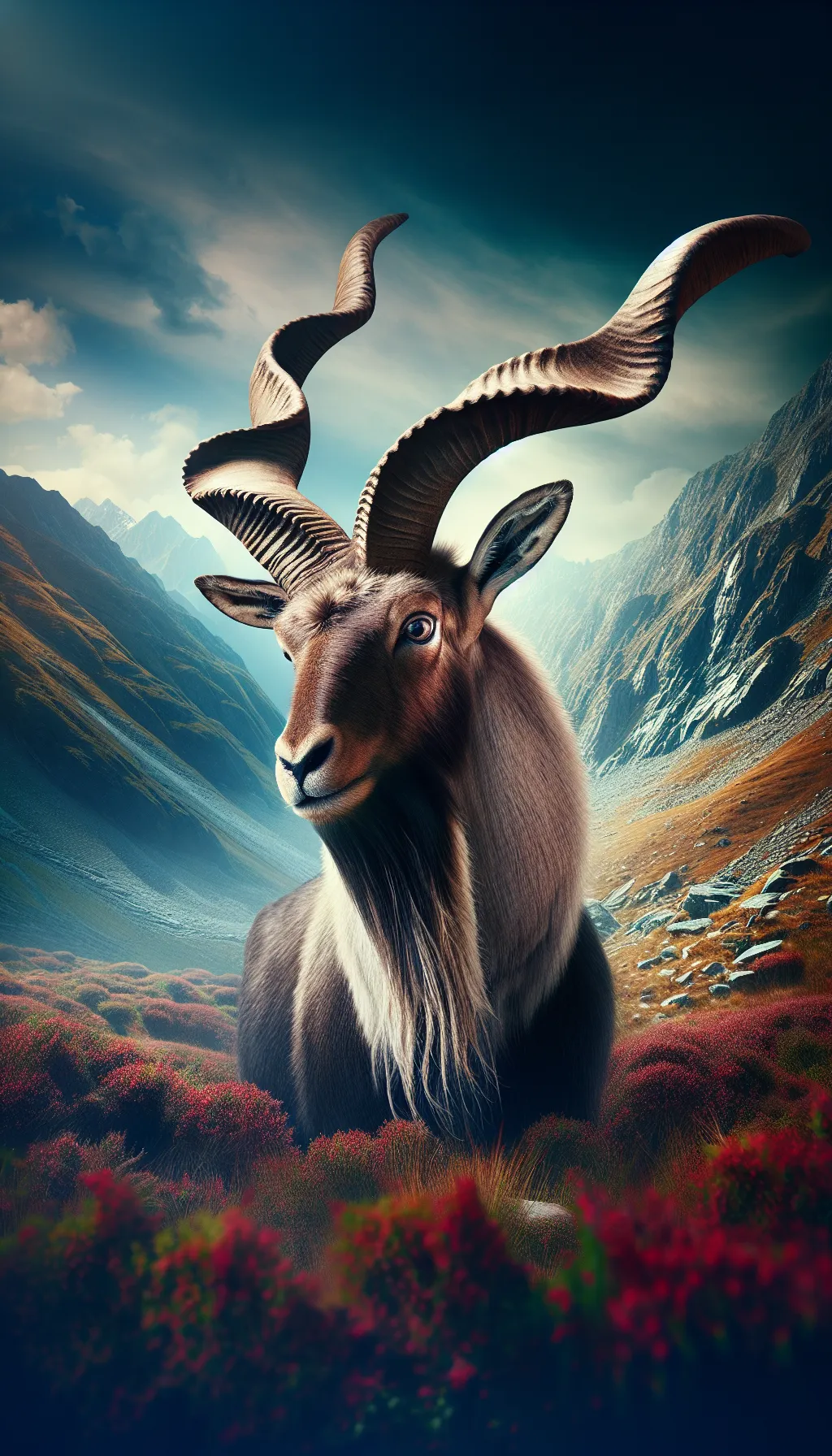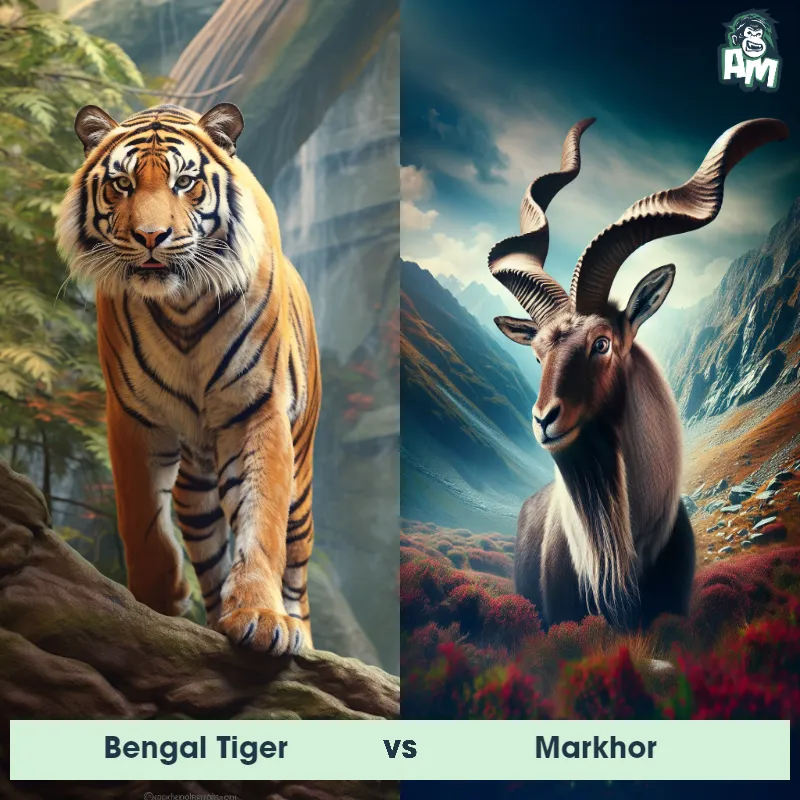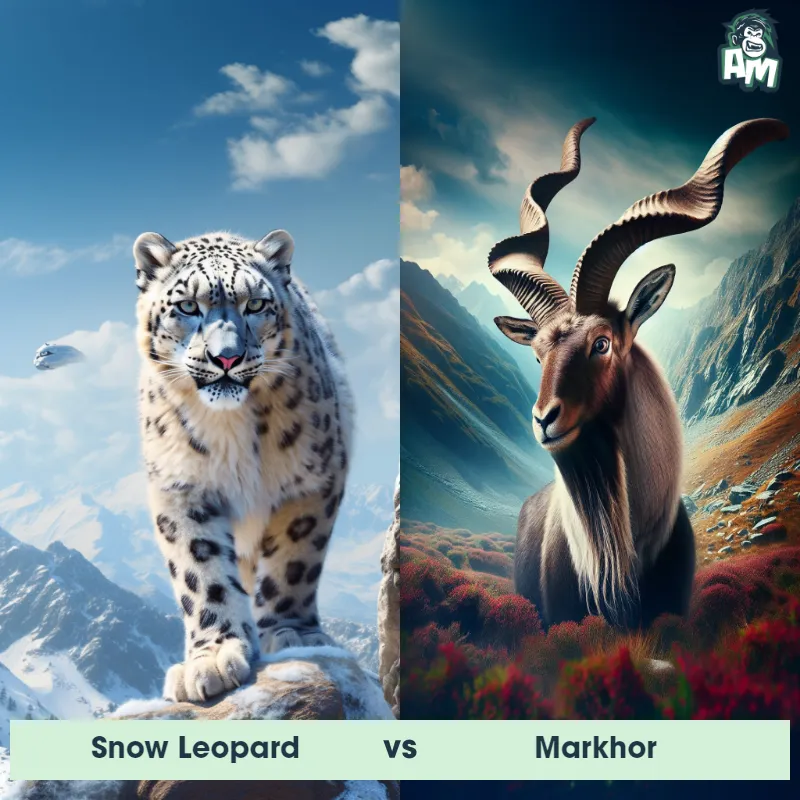The Markhor
The Markhor, also known as the screw-horn goat, is a large species of wild goat native to the mountainous regions of Central Asia. It is known for its impressive spiral horns, which can reach lengths of up to 1 meter in males and 25 centimeters in females. Markhors have a stocky build, with a coarse coat that varies in color, ranging from light gray to reddish-brown. They have a distinctive, thick beard under their chin and males have a mane of long hair on their necks. These agile climbers inhabit steep, rocky terrain and are known for their incredible jumping abilities.

| Markhor | |
|---|---|
| Size | 1.6 meters (height) (metric: 160 centimeters) |
| Weight | 100 kilograms (metric: 220 pounds) |
| Speed | 35mph (56km/h) |
| Key Strength | Horns and agility |
| Biggest Weakness | None specified |
| Scientific Name | Capra falconeri |
| Family | Bovidae |
| Habitat | Mountainous regions |
| Geography | Central Asia |
| Diet | Grass, leaves, shrubs |
| Lifespan | 10 years - 12 years |

The Markhor
The Markhor, also known as the screw-horn goat, is a large species of wild goat native to the mountainous regions of Central Asia. It is known for its impressive spiral horns, which can reach lengths of up to 1 meter in males and 25 centimeters in females. Markhors have a stocky build, with a coarse coat that varies in color, ranging from light gray to reddish-brown. They have a distinctive, thick beard under their chin and males have a mane of long hair on their necks. These agile climbers inhabit steep, rocky terrain and are known for their incredible jumping abilities.
Fun Fact: Markhors are not only excellent climbers but they are also skilled jumpers, often leaping across gaps as wide as 6 meters while scaling mountains and rocky slopes.
| Markhor | |
|---|---|
| Size | 1.6 meters (height) (metric: 160 centimeters) |
| Weight | 100 kilograms (metric: 220 pounds) |
| Speed | 35mph (56km/h) |
| Key Strength | Horns and agility |
| Biggest Weakness | None specified |
| Scientific Name | Capra falconeri |
| Family | Bovidae |
| Habitat | Mountainous regions |
| Geography | Central Asia |
| Diet | Grass, leaves, shrubs |
| Lifespan | 10 years - 12 years |
Markhor Matchups
We use AI to simulate matchups between the Markhor and other animals. Our simulation considers size, strength, and natural predatory behaviors to determine the most likely outcome.

Can't find the Matchup you want?
Create Your Own MatchupMarkhor: Diet, Predators, Aggression, and Defensive Behaviors
What do Markhor eat?
Markhor are herbivores, primarily feeding on grasses, leaves, and other plants found in their mountainous habitats. They are known to browse on a variety of vegetation, including shrubs, herbs, and fruits. During the winter months when food is scarce, they may also resort to eating twigs and bark.
Do Markhor have any predators?
Markhor face threats from various predators in their environment, including wolves, snow leopards, and occasional attacks from large birds of prey such as eagles. While adult Markhor are typically able to defend themselves against predators, young or weakened individuals are at higher risk of falling victim to these predators.
Are Markhor aggressive?
Markhor are generally not aggressive animals, preferring to avoid confrontation with other species. However, males can become aggressive during the breeding season when competing for mates or territory. They may engage in head-butting battles to establish dominance within their social hierarchy.
Do Markhor fight?
Male Markhor often engage in fights during the rutting season, which is when they compete for access to females. These fights can be intense and involve head-butting and pushing each other with their large, spiraled horns. The winner of these fights gains breeding rights, while the loser must retreat.
How do Markhor defend themselves?
Markhor have developed various defense mechanisms to protect themselves from predators and threats. Their most noticeable form of defense is their large, curved horns, which they use for fighting off predators and rival males. Additionally, Markhor are skilled climbers and can escape predators by scaling steep cliffs and rocky terrain.
What is the Markhor's biggest weakness in a fight?
Despite their impressive horns and fighting abilities, a Markhor's biggest weakness in a fight is their vulnerability to injuries sustained during battles. While their horns are effective for defense and combat, a serious injury to their head or neck could leave them susceptible to predators or infection, ultimately impacting their survival.
Fun Fact: One unique characteristic of the Markhor is the behavior known as "marking" where males use their scent glands on their faces to rub against trees and rocks to leave behind a strong odor, signaling their presence to other Markhors.
Fun Fact: The Markhor holds the distinction of having the longest horns among all wild goats, with the largest recorded pair measuring an incredible 1.6 meters in length, making them a truly impressive sight in the wild.












